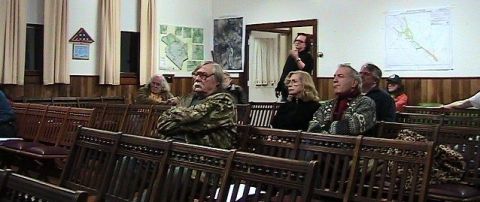
Above: Attendees at a hearing yesterday in which the Shandaken Town Board passed a new law governing farmstands. Photo by Rusty Mae Moore.
It took eight years, but the Shandaken Town Board has finally passed a farmstand law.
The new law expands the allowed size of farmstands in residential areas, which were previously permitted to be no bigger than 10 feet by 10 feet.
But Hanover Farms, the large Route 28 farmstand that has been at the center of political wrangling over Shandaken zoning law, is not automatically legalized by the new regulations. The farmstand will have to apply for a permit and comply with new regulations in order to operate legally.
In contrast to a hearing held last year on a related proposal, to rezone a stretch of Route 28 as commercial, the farmstand law hearing on Thursday, Feb. 23 drew only 16 attendees. Town board member Alfie Higley Jr., who with his father Al Higley runs the Hanover Farms farmstand, did not attend the meeting.
Supervisor Rob Stanley made an effort to forestall comments on Hanover Farms at the outset.
“Please recognize that this is not a public hearing on any specific business operating in the town. We are here to hear to comments specific to the proposed law itself,” he said.
The new law follows the existing zoning regulation for most Shandaken residential areas. On a residential parcel, only 10 percent of the land can be built on, except for parcels in the high-density residential areas in Pine Hill and Phoenicia. Farm stands continue to be defined as “accessory use” of a property, and cannot exceed more than 49 percent of the allowable “developable area.”
In practice, this means that only 4.9 percent of a residential property can be devoted to a farm stand, including all display areas and parking.
The new law also forbids the sale of anything other than plants and food products from a farmstand.
Stands must be at least 20 feet from the street line, and must be a single-story structure, or if there is a multi-story structure, the farmstand can operate only on the ground floor.
One parking space is required per 150 square feet of selling space or 200 square feet of “gross floor area,” whichever is greater. For example, a sales area of roughly 25 feet by 50 feet would require 8 parking spaces.
The law also includes provisions on signage, as well as setbacks from the road and abutting properties.
A farmstand would require a special permit from the Town Planning Board. Stanley said that in the permit process, the Planning Board would consider the concerns of local residents and neighboring property owners about lighting, noise, and other issues.
Stanley opened the hearing by reading three letters received from townspeople. Among the points mentioned in the letters were the need for a definition of the structure to be allowed, the need for a restriction on hours and lighting, the need for an explicit provision relating to restaurants or other food service related to a farm stand. One letter also expressed “shock to learn that the Board is considering a law to make Hanover Farms’ numerous violations legal.”
Audience member Tom Rinaldo of Phoenicia said that he was “basically in favor of the proposed law,” but asked if a very large residential property -- for instance, a 100-acre parcel -- might allow very large structures to be built.
“Why not control the upper limit to avoid an open-ended upper limit?” said Rinaldo.
Stanley replied that basing the allowable square footage on the size of parcels was the fairest way to legislate.
“If someone builds a 42,000 square foot farm stand, then God bless ’em,” Stanley said. “We are trying to avoid infringing on property rights.”
All four councilmembers attending the meeting (Doris Bartlett, Vincent Bernstein, Jack Jordan, and Stanley) voted in favor of the proposed law.
When asked how the law would impact Hanover Farms, Stanley said that the farmstand was not currently compliant.
"It will take about a month for the law to take effect. Presumably they will apply for a permit and take steps to comply with the new regulations,” he said.
Stanley said that he thinks the Hanover Farms site is about an acre and a half in size, and extends up the hill behind the level area where the stand is situated.












